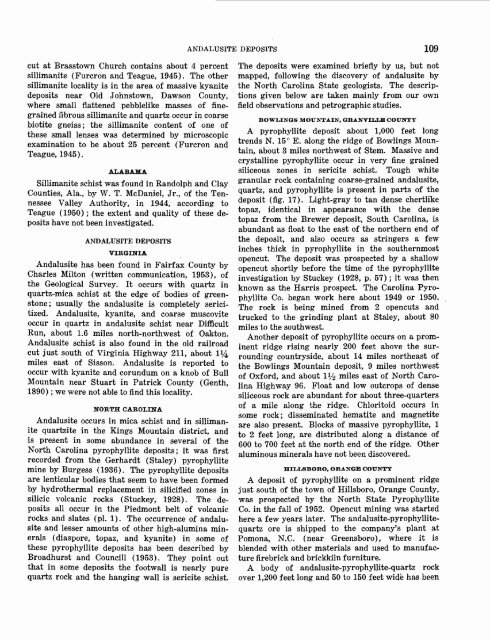Kyanite, Sillimanite, and Andalusite Deposits of the Southeastern ...
Kyanite, Sillimanite, and Andalusite Deposits of the Southeastern ...
Kyanite, Sillimanite, and Andalusite Deposits of the Southeastern ...
You also want an ePaper? Increase the reach of your titles
YUMPU automatically turns print PDFs into web optimized ePapers that Google loves.
ANDALUSITE DEPOSITS 109<br />
cut at Brasstown Church contains about 4 percent<br />
sillimanite (Furcron <strong>and</strong> Teague, 1945). The o<strong>the</strong>r<br />
sillimanite locality is in <strong>the</strong> area <strong>of</strong> massive kyanite<br />
deposits near Old Johnstown, Dawson County,<br />
where small flattened pebblelike masses <strong>of</strong> finegrained<br />
fibrous sillimanite <strong>and</strong> quartz occur in coarse<br />
biotite gneiss; <strong>the</strong> sillimanite content <strong>of</strong> one <strong>of</strong><br />
<strong>the</strong>se small lenses was determined by microscopic<br />
examination to be about 25 percent (Furcron <strong>and</strong><br />
Teague, 1945).<br />
ALABAMA<br />
<strong>Sillimanite</strong> schist was found in R<strong>and</strong>olph <strong>and</strong> Clay<br />
Counties, Ala., by W. T. McDaniel, Jr., <strong>of</strong> <strong>the</strong> Tennessee<br />
Valley Authority, in 1944, according to<br />
Teague (1950); <strong>the</strong> extent <strong>and</strong> quality <strong>of</strong> <strong>the</strong>se deposits<br />
have not been investigated.<br />
ANDALUSITE DEPOSITS<br />
VIRGINIA<br />
<strong>Andalusite</strong> has been found in Fairfax County by<br />
Charles Milton (written communication, 1953), <strong>of</strong><br />
<strong>the</strong> Geological Survey. It occurs with quartz in<br />
quartz-mica schist at <strong>the</strong> edge <strong>of</strong> bodies <strong>of</strong> greenstone;<br />
usually <strong>the</strong> <strong>and</strong>alusite is completely sericitized.<br />
<strong>Andalusite</strong>, kyanite, <strong>and</strong> coarse muscovite<br />
occur in quartz in <strong>and</strong>alusite schist near Difficult<br />
Run, about 1.6 miles north-northwest <strong>of</strong> Oakton.<br />
<strong>Andalusite</strong> schist is also found in <strong>the</strong> old railroad<br />
cut just south <strong>of</strong> Virginia Highway 211, about 1*4<br />
miles east <strong>of</strong> Sisson. <strong>Andalusite</strong> is reported to<br />
occur with kyanite <strong>and</strong> corundum on a knob <strong>of</strong> Bull<br />
Mountain near Stuart in Patrick County (Genth,<br />
1890); we were not able to find this locality.<br />
NOKTH CAROLINA<br />
<strong>Andalusite</strong> occurs in mica schist <strong>and</strong> in sillimanite<br />
quartzite in <strong>the</strong> Kings Mountain district, <strong>and</strong><br />
is present in some abundance in several <strong>of</strong> <strong>the</strong><br />
North Carolina pyrophyllite deposits; it was first<br />
recorded from <strong>the</strong> Gerhardt (Staley) pyrophyllite<br />
mine by Burgess (1936). The pyrophyllite deposits<br />
are lenticular bodies that seem to have been formed<br />
by hydro<strong>the</strong>rmal replacement in silicified zones in<br />
silicic volcanic rocks (Stuckey, 1928). The deposits<br />
all occur in <strong>the</strong> Piedmont belt <strong>of</strong> volcanic<br />
rocks <strong>and</strong> slates (pi. 1). The occurrence <strong>of</strong> <strong>and</strong>alusite<br />
<strong>and</strong> lesser amounts <strong>of</strong> o<strong>the</strong>r high-alumina minerals<br />
(diaspore, topaz, <strong>and</strong> kyanite) in some <strong>of</strong><br />
<strong>the</strong>se pyrophyllite deposits has been described by<br />
Broadhurst <strong>and</strong> Councill (1953). They point out<br />
that in some deposits <strong>the</strong> footwall is nearly pure<br />
quartz rock <strong>and</strong> <strong>the</strong> hanging wall is sericite schist.<br />
The deposits were examined briefly by us, but not<br />
mapped, following <strong>the</strong> discovery <strong>of</strong> <strong>and</strong>alusite by<br />
<strong>the</strong> North Carolina State geologists. The descriptions<br />
given below are taken mainly from our own<br />
field observations <strong>and</strong> petrographic studies.<br />
BOWLINGS MOUNTAIN, GRANVIIXE COUNTY<br />
A pyrophyllite deposit about 1,000 feet long<br />
trends N. 15° E. along <strong>the</strong> ridge <strong>of</strong> Bowlings Mountain,<br />
about 3 miles northwest <strong>of</strong> Stem. Massive <strong>and</strong><br />
crystalline pyrophyllite occur in very fine grained<br />
siliceous zones in sericite schist. Tough white<br />
granular rock containing coarse-grained <strong>and</strong>alusite,<br />
quartz, <strong>and</strong> pyrophyllite is present in parts <strong>of</strong> <strong>the</strong><br />
deposit (fig. 17). Light-gray to tan dense chertlike<br />
topaz, identical in appearance with <strong>the</strong> dense<br />
topaz from <strong>the</strong> Brewer deposit, South Carolina, is<br />
abundant as float to <strong>the</strong> east <strong>of</strong> <strong>the</strong> nor<strong>the</strong>rn end <strong>of</strong><br />
<strong>the</strong> deposit, <strong>and</strong> also occurs as stringers a few<br />
inches thick in pyrophyllite in <strong>the</strong> sou<strong>the</strong>rnmost<br />
opencut. The deposit was prospected by a shallow<br />
opencut shortly before <strong>the</strong> time <strong>of</strong> <strong>the</strong> pyrophyllite<br />
investigation by Stuckey (1928, p. 57); it was <strong>the</strong>n<br />
known as <strong>the</strong> Harris prospect. The Carolina Pyrophyllite<br />
Co. began work here about 1949 or 1950.<br />
The rock is being mined from 2 opencuts <strong>and</strong><br />
trucked to <strong>the</strong> grinding plant at Staley, about 80<br />
miles to <strong>the</strong> southwest.<br />
Ano<strong>the</strong>r deposit <strong>of</strong> pyrophyllite occurs on a prominent<br />
ridge rising nearly 200 feet above <strong>the</strong> surrounding<br />
countryside, about 14 miles nor<strong>the</strong>ast <strong>of</strong><br />
<strong>the</strong> Bowlings Mountain deposit, 9 miles northwest<br />
<strong>of</strong> Oxford, <strong>and</strong> about IVa miles east <strong>of</strong> North Carolina<br />
Highway 96. Float <strong>and</strong> low outcrops <strong>of</strong> dense<br />
siliceous rock are abundant for about three-quarters<br />
<strong>of</strong> a mile along <strong>the</strong> ridge. Chloritoid occurs in<br />
some rock; disseminated hematite <strong>and</strong> magnetite<br />
are also present. Blocks <strong>of</strong> massive pyrophyllite, 1<br />
to 2 feet long, are distributed along a distance <strong>of</strong><br />
600 to 700 feet at <strong>the</strong> north end <strong>of</strong> <strong>the</strong> ridge. O<strong>the</strong>r<br />
aluminous minerals have not been discovered.<br />
HILLSBORO, ORANGE COUNTY<br />
A deposit <strong>of</strong> pyrophyllite on a prominent ridge<br />
just south <strong>of</strong> <strong>the</strong> town <strong>of</strong> Hillsboro, Orange County,<br />
was prospected by <strong>the</strong> North State Pyrophyllite<br />
Co. in <strong>the</strong> fall <strong>of</strong> 1952. Opencut mining was started<br />
here a few years later. The <strong>and</strong>alusite-pyrophyllitequartz<br />
ore is shipped to <strong>the</strong> company's plant at<br />
Pomona, N.C. (near Greensboro), where it is<br />
blended with o<strong>the</strong>r materials <strong>and</strong> used to manufacture<br />
firebrick <strong>and</strong> brickkiln furniture.<br />
A body <strong>of</strong> <strong>and</strong>alusite-pyrophyllite-quartz rock<br />
over 1,200 feet long <strong>and</strong> 50 to 150 feet wide has been
















